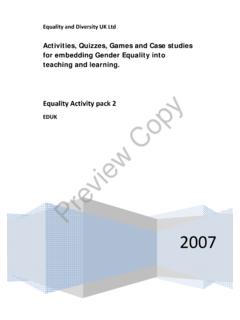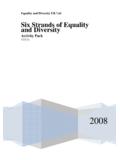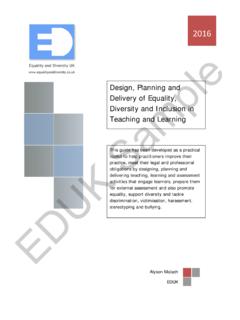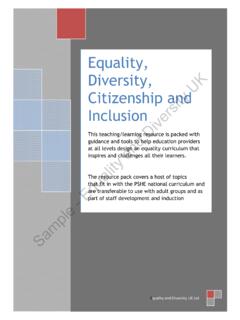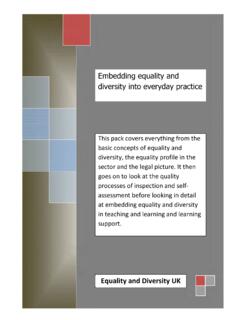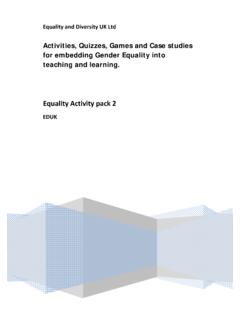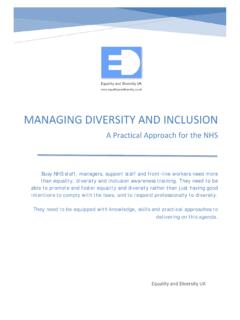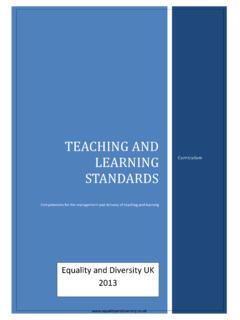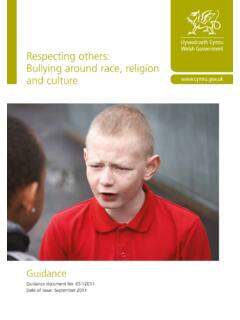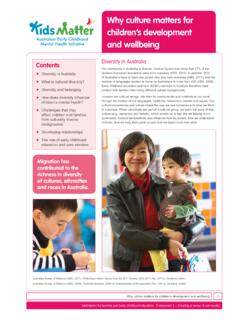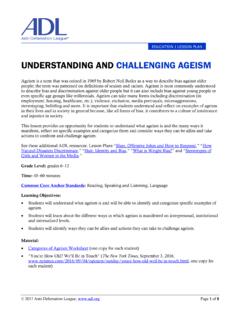Transcription of Equality Activity pack 2
1 Equality and Diversity UK Ltd 2007 Activities, Quizzes, Games and Case studies for embedding Gender Equality into teaching and learning. Equality Activity pack 2 EDUK Preview Copy1 Contents Introduction About the Activities 2 Introduction Activity Descriptions 3 Introduction Where does Equality & diversity fit in? 3 Introduction Working Ethos 8 Introduction What are the six Equality strands? 8 Introduction Equal Opportunities Legislation & Gender 9 Activity 1 Household Duties Gender Quiz 11 Activity 2 Jobs Gender Quiz 14 Activity 3 Subject Options Gender Quiz 17 Activity 4 Who Does What in Your House? 20 Activity 5 Gender Cards 23 Activity 6 Gender Bingo 26 Activity 7 Discussion Questions 29 Activity 8 Who Invented That? 32 Activity 9 Women in Mathematics 40 Activity 10 Gender Scenarios 44 Activity 11 Communication Quiz 47 Activity 12 The Glass Ceiling 56 Preview Copy2 About the Activities These entertaining and thought provoking activities give participants the opportunity to experience and/or discuss gender discrimination issues from different viewpoints and consider how gender stereotyping may unwittingly influence subject choice, their career path and the activities they engage in.
2 This Activity pack contains 12 practical tried and tested activities specifically aimed at engaging the 14-19 age group; however they can be easily adapted as required for Adult audiences. All offer the participants powerful insights into the key Equality and diversity issues surrounding gender. Each Activity plan contains the following information: Equality strand The Equality and diversity area(s) touched upon by the Activity Potential use Group sizes, potential for adaption to cover other issues, use within the programme Purpose The rationale behind the Activity Learning outcomes How participants will be able to demonstrate the knowledge or skills they will have gained by completing the Activity Resources The resources and preparation you need to do in advance of the Activity Method A step by step guide to delivering the Activity Variations How the Activity may be delivered in different ways to meet different needs or limitations Handout, cards, answer sheets, and supporting information A range of materials to support the Activity Preview Copy3 Activity Descriptions Activity 1.
3 Household Duties Gender Quiz Working individually, in groups or as a whole class, participants allocate a variety of day to day activities and tasks to male or female members of the household before discussing the reasons for their decisions and whether making choices based on gender is fair. Activity 2: Jobs Gender Quiz In a similar vein to Activity 1, participants decide whether a variety of occupations are best done by men or women or whether they could be done by either, before discussing their reasoning and considering the effects that gender stereotyping can have on career choice. Activity 3: Subject Options Gender Quiz In this Activity , participants decide which subjects are likely to appeal more to boys and which appeal more to girls before analysing their reasoning in the light of gender stereotyping, and making the link with the effects that this can have on subject choice.
4 Activity 4: Who Does What in Your House? Participants look at what happens within their own households to reveal that gender stereotyping is alive and well and thriving in their homes in the 21st century, and then consider what the adverse effects of this might be on their plans for the future. Activity 5: Gender Cards Cards featuring various sexist comments and workplace issues are used as discussion prompts to encourage participants to consider whether such behaviour is acceptable and how it may be viewed by the individuals concerned and by employers. Activity 6: Gender Bingo This is a fun and energising Activity in which participants have to find people with knowledge about role models, skills and qualities associated with traditionally gender segregated occupations and then reflect on the reasons for this. Activity 7: Discussion Questions Participants discuss issues such as perceptions about male and female personal qualities and the place of gender-related etiquette in modern society, debating the validity of these assumptions and behaviours.
5 Activity 8: Who Invented That? The message that gender is no barrier to people with ideas, talent and the will to succeed is illustrated by asking participants to guess which out of a range of inventions that have impacted on our daily lives in a big way were actually invented by women. Preview Copy4 Activity 9: Women in Mathematics The lives and achievements of four prominent female mathematicians provide the inspiration for participants to recognise the qualities required by role models and to seek out further role models in the field of mathematics. Activity 10: Gender Scenarios Real life scenarios provide the basis for discussion and allow participants to empathise with the concerns of young people considering a non-traditional career path and their friends and family, and challenge negative and sexist views. Activity 11: Communication Quiz A magazine style true or false quiz, supported by academic findings, busts some of the stereotypes about how men and women communicate with each other but confirms others, highlighting the communication skills valued in the workplace and the importance of being assertive in order to get your message across.
6 Activity 12 The Glass Ceiling Participants decide how they would challenge a real life situation where an employment agency appears to be discriminating on the grounds of gender, and consider the legal and ethical issues involved. Preview Copy5 Where does Equality and diversity fit in? Schools have a duty to promote Equality of opportunity for all students and staff, regardless of their gender, sexual orientation, race, religion or disability. Equality should be embedded in school policies on equal opportunities, behaviour and the curriculum. Understanding and respect for diversity and differences are important aspects of many areas of school life and learning. In particular, recognising the effects of bullying , stereotyping, prejudice and discrimination of any kind, and helping young people to develop the skills to challenge discrimination assertively are key elements.
7 Later, when young people enter the world of work they will be bound by Equality legislation. Life will be more rewarding if they can maintain good working relationships and respect the contributions of people of all sexes, races, religions, sexual orientations, ages and abilities. The activities in this pack can be used to support any of the following curriculum or subject areas, either in isolation, as a planned programme or Equality and diversity learning or in an off-timetable event. Many are suited to tutorial work as well as whole class or year group activities. Citizenship In the Citizenship programme of study: At Key Stage 3 pupils should be taught about: the legal and human rights and responsibilities underpinning society, basic aspects of the criminal justice system, and how both relate to young people At Key Stage 4 pupils should be taught about: the legal and human rights and responsibilities underpinning society and how they relate to citizens, including the role and operation of the criminal and civil justice systems the rights and responsibilities of consumers, employers and employees Source: Personal, Social and Health Education In the Personal, Social and Health Education guidelines: At Key Stage 3 pupils should be taught.
8 To respect the differences between people as they develop their own sense of identity about the effects of all types of stereotyping, prejudice, bullying , racism and discrimination and how to challenge them assertively Preview Copy6 how to empathise with people different from themselves to recognise some of the cultural norms in society, including the range of lifestyles and relationships to resist pressure to do wrong, to recognise when others need help and how to support them to consider social and moral dilemmas At Key Stage 4 pupils should be taught: to have a sense of their own identity and present themselves confidently in a range of situations to challenge offending behaviour, prejudice, bullying , racism and discrimination assertively and take the initiative in giving and receiving support to work co-operatively with a range of people who are different from themselves to consider social and moral dilemmas Source: Careers Education and Guidance The Careers Education and Guidance framework offers guidance on preparing young people for the opportunities, responsibilities and experiences of adult life.
9 Understanding themselves and the influences on them (self-development) is one of the key aims and the framework specifically recommends the following learning outcomes: By the age of 14, young people should have acquired the knowledge, understanding and skills to: recognise stereotyped and misrepresented images of people, careers and work and how their own views of these issues affect their decision making recognise and respond to the main influences on their attitudes and values in relation to learning, work and Equality of opportunity By the age of 16, young people should have acquired the knowledge, understanding and skills to: explain why it is important to develop personal values to combat stereotyping, tackle discrimination in learning and work and suggest ways of doing this use guided self-exploration to recognise and respond appropriately to the main influences on their attitudes, values and behaviour in relation to learning and work Preview Copy7 By the age of 19, young people should have acquired the knowledge, understanding and skills to: describe and evaluate personal action to promote equal opportunities and respect for diversity evaluate the impact of external influences on personal views, attitudes, behaviour and career plans and respond appropriately Source: Department for Education and Skills (2003) Careers Education and Guidance in England.
10 A national framework 11-19, DfES The popular Better Practice resource offering practical help on leading, managing and delivering effective careers education has now been updated to include a whole chapter on Promoting Equal Opportunities. Source: Better Practice II Practical Strategies for Developing Excellence in Careers Education (2007) AICE/ACEG Work-Related Learning Some of the activities and challenges set in work-related contexts meet the elements of provision of the framework for Work-Related Learning at Key Stage 4, which require students to: learn about the way business enterprises operate, working roles and conditions, and rights and responsibilities in the workplace Source: Qualifications and Curriculum Authority (2003) Work Related Learning for all at Key Stage 4, QCA bullying Since September 1999, schools have had specific duties to combat bullying and must have anti- bullying policies and procedures in place.
